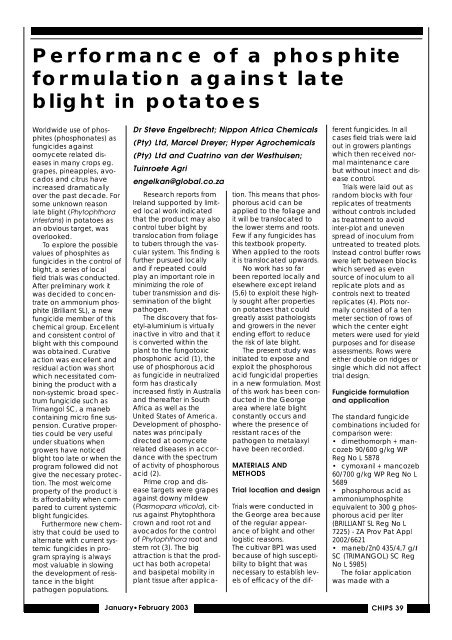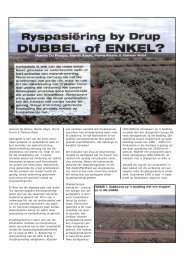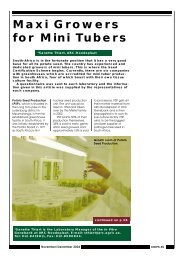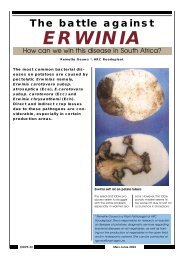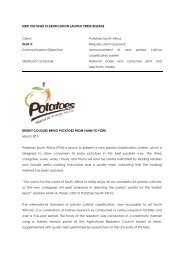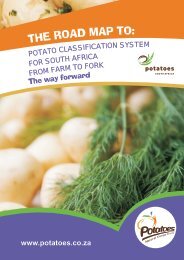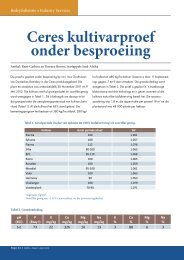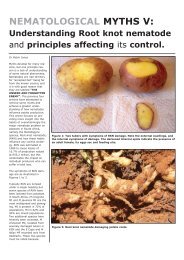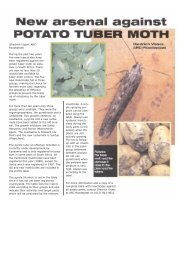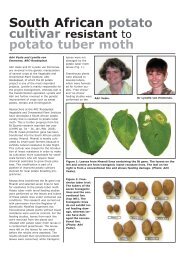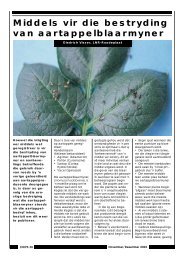Performance of a phosphite formulation against late blight in potatoes
Performance of a phosphite formulation against late blight in potatoes
Performance of a phosphite formulation against late blight in potatoes
Create successful ePaper yourself
Turn your PDF publications into a flip-book with our unique Google optimized e-Paper software.
<strong>Performance</strong> <strong>of</strong> a <strong>phosphite</strong><br />
<strong>formulation</strong> <strong>aga<strong>in</strong>st</strong> <strong>late</strong><br />
<strong>blight</strong> <strong>in</strong> <strong>potatoes</strong><br />
Worldwide use <strong>of</strong> <strong>phosphite</strong>s<br />
(phosphonates) as<br />
fungicides <strong>aga<strong>in</strong>st</strong><br />
oomycete re<strong>late</strong>d diseases<br />
<strong>in</strong> many crops eg.<br />
grapes, p<strong>in</strong>eapples, avocados<br />
and citrus have<br />
<strong>in</strong>creased dramatically<br />
over the past decade. For<br />
some unknown reason<br />
<strong>late</strong> <strong>blight</strong> (Phytophthora<br />
<strong>in</strong>festans) <strong>in</strong> <strong>potatoes</strong> as<br />
an obvious target, was<br />
overlooked.<br />
To explore the possible<br />
values <strong>of</strong> <strong>phosphite</strong>s as<br />
fungicides <strong>in</strong> the control <strong>of</strong><br />
<strong>blight</strong>, a series <strong>of</strong> local<br />
field trials was conducted.<br />
After prelim<strong>in</strong>ary work it<br />
was decided to concentrate<br />
on ammonium <strong>phosphite</strong><br />
(Brilliant SL), a new<br />
fungicide member <strong>of</strong> this<br />
chemical group. Excellent<br />
and consistent control <strong>of</strong><br />
<strong>blight</strong> with this compound<br />
was obta<strong>in</strong>ed. Curative<br />
action was excellent and<br />
residual action was short<br />
which necessitated comb<strong>in</strong><strong>in</strong>g<br />
the product with a<br />
non-systemic broad spectrum<br />
fungicide such as<br />
Trimangol SC, a maneb<br />
conta<strong>in</strong><strong>in</strong>g micro f<strong>in</strong>e suspension.<br />
Curative properties<br />
could be very useful<br />
under situations when<br />
growers have noticed<br />
<strong>blight</strong> too <strong>late</strong> or when the<br />
program followed did not<br />
give the necessary protection.<br />
The most welcome<br />
property <strong>of</strong> the product is<br />
its affordability when compared<br />
to current systemic<br />
<strong>blight</strong> fungicides.<br />
Furthermore new chemistry<br />
that could be used to<br />
alternate with current systemic<br />
fungicides <strong>in</strong> program<br />
spray<strong>in</strong>g is always<br />
most valuable <strong>in</strong> slow<strong>in</strong>g<br />
the development <strong>of</strong> resistance<br />
<strong>in</strong> the <strong>blight</strong><br />
pathogen populations.<br />
Dr Steve Engelbrecht; Nippon Africa Chemicals<br />
(Pty) Ltd, Marcel Dreyer; Hyper Agrochemicals<br />
(Pty) Ltd and Cuatr<strong>in</strong>o van der Westhuisen;<br />
Tu<strong>in</strong>roete Agri<br />
engelkan@global.co.za<br />
Research reports from<br />
Ireland supported by limited<br />
local work <strong>in</strong>dicated<br />
that the product may also<br />
control tuber <strong>blight</strong> by<br />
translocation from foliage<br />
to tubers through the vascular<br />
system. This f<strong>in</strong>d<strong>in</strong>g is<br />
further pursued locally<br />
and if repeated could<br />
play an important role <strong>in</strong><br />
m<strong>in</strong>imiz<strong>in</strong>g the role <strong>of</strong><br />
tuber transmission and dissem<strong>in</strong>ation<br />
<strong>of</strong> the <strong>blight</strong><br />
pathogen.<br />
The discovery that fosetyl-alum<strong>in</strong>ium<br />
is virtually<br />
<strong>in</strong>active <strong>in</strong> vitro and that it<br />
is converted with<strong>in</strong> the<br />
plant to the fungotoxic<br />
phosphonic acid (1), the<br />
use <strong>of</strong> phosphorous acid<br />
as fungicide <strong>in</strong> neutralized<br />
form has drastically<br />
<strong>in</strong>creased firstly <strong>in</strong> Australia<br />
and thereafter <strong>in</strong> South<br />
Africa as well as the<br />
United States <strong>of</strong> America.<br />
Development <strong>of</strong> phosphonates<br />
was pr<strong>in</strong>cipally<br />
directed at oomycete<br />
re<strong>late</strong>d diseases <strong>in</strong> accordance<br />
with the spectrum<br />
<strong>of</strong> activity <strong>of</strong> phosphorous<br />
acid (2).<br />
Prime crop and disease<br />
targets were grapes<br />
<strong>aga<strong>in</strong>st</strong> downy mildew<br />
(Plasmopara viticola), citrus<br />
<strong>aga<strong>in</strong>st</strong> Phytophthora<br />
crown and root rot and<br />
avocados for the control<br />
<strong>of</strong> Phytophthora root and<br />
stem rot (3). The big<br />
attraction is that the product<br />
has both acropetal<br />
and basipetal mobility <strong>in</strong><br />
plant tissue after application.<br />
This means that phosphorous<br />
acid can be<br />
applied to the foliage and<br />
it will be translocated to<br />
the lower stems and roots.<br />
Few if any fungicides has<br />
this textbook property.<br />
When applied to the roots<br />
it is translocated upwards.<br />
No work has so far<br />
been reported locally and<br />
elsewhere except Ireland<br />
(5,6) to exploit these highly<br />
sought after properties<br />
on <strong>potatoes</strong> that could<br />
greatly assist pathologists<br />
and growers <strong>in</strong> the never<br />
end<strong>in</strong>g effort to reduce<br />
the risk <strong>of</strong> <strong>late</strong> <strong>blight</strong>.<br />
The present study was<br />
<strong>in</strong>itiated to expose and<br />
exploit the phosphorous<br />
acid fungicidal properties<br />
<strong>in</strong> a new <strong>formulation</strong>. Most<br />
<strong>of</strong> this work has been conducted<br />
<strong>in</strong> the George<br />
area where <strong>late</strong> <strong>blight</strong><br />
constantly occurs and<br />
where the presence <strong>of</strong><br />
resistant races <strong>of</strong> the<br />
pathogen to metalaxyl<br />
have been recorded.<br />
MATERIALS AND<br />
METHODS<br />
Trial location and design<br />
Trials were conducted <strong>in</strong><br />
the George area because<br />
<strong>of</strong> the regular appearance<br />
<strong>of</strong> <strong>blight</strong> and other<br />
logistic reasons.<br />
The cultivar BP1 was used<br />
because <strong>of</strong> high susceptibility<br />
to <strong>blight</strong> that was<br />
necessary to establish levels<br />
<strong>of</strong> efficacy <strong>of</strong> the different<br />
fungicides. In all<br />
cases field trials were laid<br />
out <strong>in</strong> growers plant<strong>in</strong>gs<br />
which then received normal<br />
ma<strong>in</strong>tenance care<br />
but without <strong>in</strong>sect and disease<br />
control.<br />
Trials were laid out as<br />
random blocks with four<br />
replicates <strong>of</strong> treatments<br />
without controls <strong>in</strong>cluded<br />
as treatment to avoid<br />
<strong>in</strong>ter-plot and uneven<br />
spread <strong>of</strong> <strong>in</strong>oculum from<br />
untreated to treated plots.<br />
Instead control buffer rows<br />
were left between blocks<br />
which served as even<br />
source <strong>of</strong> <strong>in</strong>oculum to all<br />
replicate plots and as<br />
controls next to treated<br />
replicates (4). Plots normally<br />
consisted <strong>of</strong> a ten<br />
meter section <strong>of</strong> rows <strong>of</strong><br />
which the center eight<br />
meters were used for yield<br />
purposes and for disease<br />
assessments. Rows were<br />
either double on ridges or<br />
s<strong>in</strong>gle which did not affect<br />
trial design.<br />
Fungicide <strong>formulation</strong><br />
and application<br />
The standard fungicide<br />
comb<strong>in</strong>ations <strong>in</strong>cluded for<br />
comparison were:<br />
• dimethomorph + mancozeb<br />
90/600 g/kg WP<br />
Reg No L 5878<br />
• cymoxanil + mancozeb<br />
60/700 g/kg WP Reg No L<br />
5689<br />
• phosphorous acid as<br />
ammonium<strong>phosphite</strong><br />
equivalent to 300 g phosphorous<br />
acid per liter<br />
(BRILLIANT SL Reg No L<br />
7225) - ZA Prov Pat Appl<br />
2002/6621<br />
• maneb/Zn0 435/4,7 g/l<br />
SC (TRIMANGOL) SC Reg<br />
No L 5985)<br />
The foliar application<br />
was made with a<br />
January•February 2003 CHIPS 39
Technoma backpack<br />
sprayer fitted with 0,05 hollow<br />
cone nozzles, operated<br />
at a pressure <strong>of</strong> ca 1,5<br />
bar <strong>in</strong> volumes vary<strong>in</strong>g<br />
from 250-1000l water per<br />
hectare. Rows were<br />
sprayed from both sides to<br />
ensure even distribution <strong>of</strong><br />
fungicide deposit on the<br />
foliage. At these volumes<br />
complete cover was not<br />
possible especially at <strong>late</strong>r<br />
stages when the plants<br />
approached maximum<br />
size.<br />
Blight and defoliation<br />
assessments:<br />
• compound leaves with<br />
<strong>blight</strong> symptoms. - The 3rd<br />
and 4th fully expanded<br />
compound leaves from<br />
the apical tips on ten random<br />
v<strong>in</strong>es from the center<br />
eight meter section <strong>of</strong><br />
each replicate plot were<br />
collected and rated as<br />
“with symptoms” and<br />
“without symptoms”.<br />
• defoliation. - 20 v<strong>in</strong>es<br />
were randomly chosen<br />
from the center <strong>of</strong> each<br />
replicate plot and the percent<br />
defoliation recorded.<br />
The average <strong>of</strong> two unbiased<br />
rat<strong>in</strong>gs was taken as<br />
a representative figure.<br />
Yield and density <strong>of</strong><br />
tubers<br />
Only <strong>in</strong> one trial was the<br />
yield measured, where<br />
eight meters <strong>of</strong> the center<br />
<strong>of</strong> ten meter rows were lifted<br />
and the tubers graded<br />
<strong>in</strong>to large, medium and<br />
small and the mass <strong>of</strong><br />
each category recorded.<br />
Composite samples <strong>of</strong><br />
randomly chosen tubers <strong>of</strong><br />
each <strong>of</strong> the four replicates<br />
<strong>of</strong> each treatment were<br />
subjected to density test<strong>in</strong>g<br />
with Food Association<br />
potato hydrometer at<br />
Tu<strong>in</strong>roeteAgri. Similar samples<br />
were collected from<br />
four control replicates,<br />
pooled and subjected to<br />
the same tests and<br />
expressed <strong>in</strong> g/cm 3 .<br />
Analyses<br />
Results were subjected to<br />
analyses <strong>of</strong> variance by<br />
The Biometrics Unit <strong>of</strong> the<br />
ARC, Silverton, Pretoria<br />
and treatment means<br />
compared with the Fischer<br />
LSD test. Treatment means<br />
<strong>in</strong> tables below followed<br />
by the same letter do not<br />
Table 1 The effect <strong>of</strong> two curative sprays on defoliation <strong>of</strong> BP1 <strong>potatoes</strong> due to<br />
<strong>late</strong> <strong>blight</strong>. 29.03.2000. Boplaas, George. JA Barnard.<br />
treatment dosage product % defoliation as on<br />
per ha 29.03.200<br />
1.control* - no fungicide - 86,2 a<br />
2. cymoxanil/mancozeb 60/700 g/kg WP 3 kg 7,5 b<br />
3. Brilliant SL 300 g phosphorous acid eq. per l 6,7 l 11,3 b<br />
(not comb<strong>in</strong>ed with Trimangol SC)<br />
* In this trial a control was <strong>in</strong>cluded as a treatment.<br />
Table 2 The effect <strong>of</strong> program spray<strong>in</strong>g with systemic fungicides on <strong>late</strong> <strong>blight</strong><br />
levels on BP1 <strong>potatoes</strong>. Skimmelkrans, George. G Botha.<br />
fungicide c<strong>of</strong>ormulations/mixtures dosage product mean % compound<br />
per ha<br />
leaves <strong>blight</strong> free<br />
1. dimethomorph/mancozeb 90/600 g/kg WP 2,0 kg 80,0 c<br />
2. ammonium<strong>phosphite</strong> 300 g/ l phosphorous 6,7 l + 2,0 kg 89,4 ab<br />
acid eq. (Brilliant SL) + maneb/ZnO 435/4,7 g/l (tank mixed)<br />
SL (Trimangol SC)<br />
differ significantly at the 95<br />
% probability level.<br />
RESULTS AND<br />
DISCUSSION<br />
In the tables below only<br />
the relevant treatments<br />
with their significance are<br />
listed as other treatments<br />
are still under review for<br />
registration.<br />
Boplaas, JA Barnard,<br />
George. BP1 <strong>potatoes</strong><br />
planted 18 Jan 2000.<br />
Two applications were<br />
applied on 17 and<br />
23/03/2000 before defoliation<br />
assessments were<br />
made on 29/03/2000.<br />
Blight was firmly established<br />
at time <strong>of</strong> first spray<br />
and <strong>of</strong>fered excellent circumstances<br />
for the test<strong>in</strong>g<br />
<strong>of</strong> the curative properties<br />
<strong>of</strong> the fungicides. (See<br />
Table 1)<br />
Skimmelkrans, G Botha<br />
George. BP1 <strong>potatoes</strong><br />
planted 03.10.2001.<br />
The applications were<br />
made on 23.11.2001,<br />
30.11.2001, 07.12.2001,<br />
14.12.2001, 21.12.2001 and<br />
03.01.2002. The <strong>blight</strong><br />
assessments were made<br />
on 09.01.2002 at a stage<br />
when the control rows<br />
were almost completely<br />
defoliated. (See Table 2)<br />
Buffelsdrift, G Barnard,<br />
George. BP1 <strong>potatoes</strong><br />
planted 1st week <strong>of</strong> July<br />
2002.<br />
The application dates<br />
were 12.09.2002,<br />
Table 3 The effect <strong>of</strong> three critical curative sprays on the progress <strong>of</strong> <strong>blight</strong> on BP1 <strong>potatoes</strong>. Buffelsdrift,<br />
George. 03.10.2002.<br />
fungicide dosage as product per ha percent <strong>blight</strong> control tuber yield (kg) specific gravity <strong>of</strong><br />
3.10.2002 per 5m row 14.11.2002 tubers(g/cm3)14.11.2002<br />
1. dimethomorph 2,0 kg 72,50 a (92,5)* 15,05 a 1,083 (1,078)*<br />
+mancozeb<br />
90/600 g/kg WP<br />
2. ammonium-<strong>phosphite</strong> 6,7l plus 2,0 kg 88,61 b (84,4)* 14,80 a 1,088 (1,075)*<br />
300 g/l phosphorous (tank mixed) * number <strong>in</strong> bracket above *number <strong>in</strong><br />
acid eq.(Brilliant SL) is the mean % leaves bracket above is<br />
+ maneb/ZnO with symptoms <strong>in</strong> mean recorded<br />
435/4,7 g/l SC adjacent controls for control tubers<br />
(Trimangol SC)<br />
CHIPS 40<br />
Januarie•Februarie 2003
19.09.2002, 26.09.2002,<br />
03.10.2002,10.10.2002,<br />
17.10.2002, 24.10.2002 and<br />
02.11.2002. Blight assessments<br />
were made on<br />
03.10.2002.<br />
At the stage when the<br />
trial was <strong>in</strong>itiated on 10.10<br />
the grower had already<br />
commenced with chemical<br />
control which was subsequently<br />
followed by the<br />
treatments <strong>in</strong> the trial<br />
area. (See Table 3)<br />
In the above trials situations<br />
were deliberately<br />
chosen where <strong>blight</strong> epidemics<br />
had already started<br />
<strong>in</strong> plant<strong>in</strong>gs with many<br />
<strong>in</strong>fections <strong>in</strong> <strong>in</strong>cubation<br />
phase before the first<br />
curative application was<br />
made. This would test the<br />
curative properties <strong>of</strong> the<br />
different fungicides <strong>in</strong>cluded.<br />
In above tables only<br />
the treatments that are<br />
relevant are listed.<br />
In all three trials above<br />
Brilliant SL resulted <strong>in</strong> outstand<strong>in</strong>g<br />
curative control<br />
<strong>of</strong> <strong>blight</strong> and proved to<br />
be very useful <strong>in</strong> situations<br />
where <strong>in</strong>fections have<br />
progressed beyond the<br />
reach <strong>of</strong> preventive fungicides<br />
such as the dithiocarbamates<br />
mancozeb<br />
and maneb or chlorothalonil<br />
(3). The fact that it<br />
is translocated downwards<br />
soon after application<br />
to the lower stems<br />
and tubers, results <strong>in</strong> a<br />
very short residual action<br />
and must be assisted with<br />
a residual fungicide (5,6).<br />
In the work reported here<br />
maneb <strong>in</strong> micro f<strong>in</strong>e suspension<br />
was chosen as<br />
mix<strong>in</strong>g partner because it<br />
is also a liquid (Trimangol<br />
SC) and would compliment<br />
Brilliant SL <strong>in</strong> this<br />
respect.<br />
In the last two trials<br />
Brilliant SL was partnered<br />
with a residual fungicide<br />
and the cumulative curative<br />
and residual effect as<br />
reflected <strong>in</strong> the <strong>blight</strong><br />
level at that stage can<br />
hardly be bettered as <strong>in</strong>dicated<br />
by the comparative<br />
numbers (Tables 1,2 &<br />
3) (Figs 1 & 2) Work on the<br />
Mpumalanga Highveld<br />
not reported here, clearly<br />
<strong>in</strong>dicated the excellent<br />
curative action but also<br />
the need to comb<strong>in</strong>e the<br />
product with a residual<br />
partner.<br />
The basipetal movement<br />
<strong>of</strong> <strong>phosphite</strong> ions to<br />
the tubers via the vascular<br />
system after foliar application<br />
and suppression <strong>of</strong><br />
tuber <strong>in</strong>fection is <strong>of</strong> great<br />
significance as tuber<br />
transmission and its role as<br />
source <strong>of</strong> primary <strong>in</strong>oculum<br />
and spread <strong>of</strong> <strong>blight</strong><br />
can now possibly be<br />
addressed. This property<br />
and the <strong>in</strong>crease <strong>in</strong> specific<br />
gravity <strong>of</strong> tubers from<br />
plants treated foliarly with<br />
<strong>phosphite</strong> (Table 3) are<br />
currently under review.<br />
The work reported here<br />
provides further evidence<br />
<strong>of</strong> the activity <strong>of</strong> phospites<br />
(phosphonates) <strong>aga<strong>in</strong>st</strong><br />
oomycete re<strong>late</strong>d diseases<br />
on <strong>potatoes</strong> such as<br />
<strong>late</strong> <strong>blight</strong> (Phytophthora<br />
<strong>in</strong>festans). Of great <strong>in</strong>terest<br />
to growers is the very<br />
favourable cost pr<strong>of</strong>ile<br />
when compared to exist<strong>in</strong>g<br />
systemic <strong>blight</strong> fungicides.<br />
Growers are cautioned<br />
that resistance by<br />
the <strong>late</strong> <strong>blight</strong> pathogen<br />
to <strong>phosphite</strong> as <strong>in</strong> Brilliant<br />
SL, despite the mix<strong>in</strong>g with<br />
Trimangol SC, could<br />
become a reality and<br />
should the mixture therefore<br />
be alternated with<br />
chemically unre<strong>late</strong>d<br />
products.<br />
References:<br />
1.Fenn ME and C<strong>of</strong>fey MD, Quantification <strong>of</strong> phosphonate and ethyl phosphonate <strong>in</strong><br />
tobacco and tomato tissue and significance for the mode <strong>of</strong> action <strong>of</strong> two phosphonate<br />
fungicides Phytopathology 79: 76-82 (1989)<br />
2. Fenn ME and C<strong>of</strong>fey MD, Studies on the <strong>in</strong> vitro and <strong>in</strong> vivo antifungal activity <strong>of</strong><br />
fosetyl-Al and phosphorous acid. Phytopathology 74: 606-611 (1984).<br />
3. Nel Annette, Mareli Krausse, Neervana Ramautar and Kathy van Zyl A Guide for<br />
the Control <strong>of</strong> Plant Diseases. National Department <strong>of</strong> Agriculture, Directorate:<br />
Agricultural Production Inputs (1999).<br />
4. Van der Plank JE, Plant Diseases: Epidemics and Control, Academic Press. 1936 p<br />
286.<br />
5. Cooke LR and Little G, Foliar application <strong>of</strong> phosphonate <strong>formulation</strong>s for the control<br />
<strong>of</strong> potato tuber <strong>blight</strong>, <strong>in</strong> Proc Brit Crop Prot ñ Pests and Diseases, BCPC, Farnham,<br />
Surrey,UK. Pp 263-268 (1996).<br />
6. Cooke LR and Little G, The effect <strong>of</strong> foliar applications <strong>of</strong> phosphonate <strong>formulation</strong>s<br />
on the susceptibility <strong>of</strong> potato tubers to <strong>late</strong> <strong>blight</strong>. Pest Manag Sci 58: 17-25 (<br />
2002).<br />
Photo left: A view on BP1<br />
potato plants <strong>in</strong> a field trial<br />
after three sprays with<br />
dimethomorph + mancozeb<br />
90/600 g/kg WP at 2 kg/ha<br />
(Reference registered standard<br />
fungicide). Buffelsdrift,<br />
George, 3 October 2002.<br />
Photo right: A view on BP1<br />
potato plants <strong>in</strong> a field trial<br />
after three sprays with a tank<br />
mixture <strong>of</strong> HYPERPHOS 300 (=<br />
Brilliant SL) (300 g phosphorous<br />
acid equivalent per liter<br />
(6,7 liter per ha) and TRIMAN-<br />
GOL SC (435/4,7g<br />
maneb/ZnO per liter) (2,0 liter<br />
per ha). Untreated control on<br />
the right. Buffelsdrift, George,<br />
3 October 2002.<br />
January•February 2003 CHIPS 41


